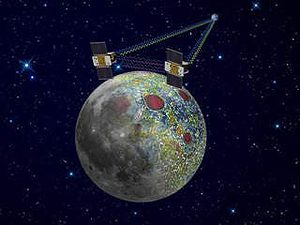
Ebb and Flow chased each other around the moon for nearly a year, peering into the interior. With dwindling fuel supplies, the twin NASA spacecraft are ready for a dramatic finish.
Photographer: NASA
At the end of last year, NASA permanently decommissioned the spacecrafts Ebb and Flow after engineers intentionally crashed them on the moon’s surface. Now, the space agency has released video footage from the last moments of spacecraft Ebb just before it hit, which can watch just below. Prepare for some goosebumps.
The two spacecraft were part of a mission known as GRAIL, tasked with mapping the moon’s gravity. The $496m Grail mision launched in September 2011, and its two craft Ebb and Flow were placed in orbit three months later, and since then they’ve well made up for their money’s worth. Besides the actual gravity mapping that’s extremely important to scientists trying to understand how it formed, the Grail mission help better our understanding of the moon’s interior, found evidence of water in the moon’s craters, and captured the first photos from the dark side of the moon.
The final moments of Ebb have been documented in two separate instances, filmed with the Moon Knowledge Acquired by Middle school students camera (or MoonKam), in honor of the fact that a student picked what the camera should film. It took 2,400 frames to make the two-minute video, which runs at six times normal speed and which captures the moon’s surface in extraordinary high detail. You might find yourself thinking this is a sort of video game or something, but make no mistake that’s the moon, my friends! NASA announced that the crash site would be named after the late Sally Ride, America’s first woman in space.









